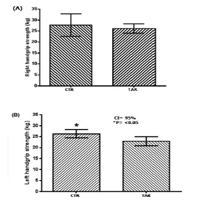Is there an association between upper limb claudication and handgrip strength in Takayasu arteritis?

Submitted: 17 May 2020
Accepted: 29 October 2020
Published: 18 January 2021
Accepted: 29 October 2020
Abstract Views: 757
PDF: 510
Publisher's note
All claims expressed in this article are solely those of the authors and do not necessarily represent those of their affiliated organizations, or those of the publisher, the editors and the reviewers. Any product that may be evaluated in this article or claim that may be made by its manufacturer is not guaranteed or endorsed by the publisher.
All claims expressed in this article are solely those of the authors and do not necessarily represent those of their affiliated organizations, or those of the publisher, the editors and the reviewers. Any product that may be evaluated in this article or claim that may be made by its manufacturer is not guaranteed or endorsed by the publisher.
Similar Articles
- D. Schneider, M. Hirsch, Acute calcific tendonitis of dorsal interosseous muscles of the hand: uncommon site of a frequent disease , Reumatismo: Vol. 69 No. 1 (2017)
- A.B. Rasheed, M.S. Daoud, F.I. Gorial, Diagnostic utility of serum melatonin levels in systemic lupus erythematosus: a case-control study , Reumatismo: Vol. 69 No. 4 (2017)
- M. Romano, I. Pontikaki, M. Gattinara, I. Ardoino, C. Donati, P. Boracchi, P.L. Meroni, V. Gerloni, Drug survival and reasons for discontinuation of the first course of biological therapy in 301 juvenile idiopathic arthritis patients , Reumatismo: Vol. 65 No. 6 (2013)
- R. Neri, M. Mosca, T. Grazzini, A. Tavoni, G. Pasero, S. Bombardieri, Long term functional outcome of idiopathic inflammatory myopathies , Reumatismo: Vol. 53 No. 1 (2001)
- E. Chessa, M. Piga, A. Floris, A. Mathieu, A. Cauli, Demyelinating syndrome in SLE: review of different disease subtypes and report of a case series , Reumatismo: Vol. 69 No. 4 (2017)
- F. Salaffi, A. Stancati, A. Silvestri, M. Carotti, W. Grassi, Validation of the Italian versions of the Bath Ankylosing Spondylitis Functional Index (BASFI) and the Dougados Functional Index (DFI) in patients with ankylosing spondylitis , Reumatismo: Vol. 57 No. 3 (2005)
- G. De Rosa, A. De Nisco, M. Piastra, P. Valentini, D. Rigante, Efficacy of high-dose methylprednisolone pulses in a child with noninfectious persistent pleuropericarditis revealing systemic juvenile idiopathic arthritis , Reumatismo: Vol. 68 No. 2 (2016)
- M. Aouatef, B. Asma, H. Hajer, A. Charfeddine, B. Lamia, K. Taoufik, Work-related carpal tunnel syndrome treatment: a cross-sectional study among 106 patients , Reumatismo: Vol. 69 No. 2 (2017)
- N. Pugliese, M. Bruzzone, A. Della Rossa, C. Baldini, E. Catarsi, A. Tavoni, A. d'Ascanio, S. Bombardieri, Churg-Strauss vasculitis and idiopathic hypereosinophyl syndrome: role of molecular biology in the differential diagnosis of hypereosinophyl syndrome , Reumatismo: Vol. 60 No. 2 (2008)
- A. Belotti Masserini, S. Zeni, R. Cossutta, A. Soldi, F. Fantini, Cost-of-illness in systemic sclerosis: a retrospective study of an italian cohort of 106 patients , Reumatismo: Vol. 55 No. 4 (2003)
<< < 1 2 3 4 5 6 7 8 9 10 > >>
You may also start an advanced similarity search for this article.

 https://doi.org/10.4081/reumatismo.2020.1298
https://doi.org/10.4081/reumatismo.2020.1298




